Gooseberry tart is one of my family’s recipes that have been passed down through the generations. There is something about this dessert that brings people together. The joy of a juicy gooseberry fruit that’s just been picked, eaten fresh, or whipping up delicious recipes with these gems, is one of life’s simple joys.
In our gooseberry guide, we explore some of the popular varieties that we find in Australia. Learn how to propagate your own gooseberry shrub by taking cuttings, and how to best care for your shrub.
We’ll also go through the culinary use and harvesting of gooseberry fruit too.
More...
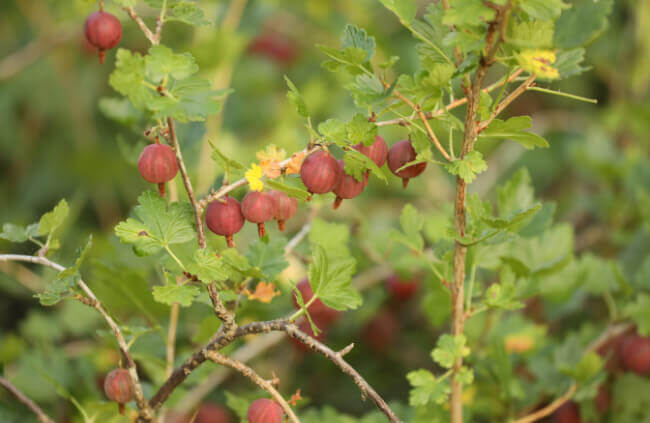
Family: | Grossulariaceae |
|---|---|
Genus: | Ribes |
Species: | R. uva-crispa |
Origin: | Europe |
Common Names: | Gooseberry |
Location: | Indoor and outdoor |
Type: | Shrub |
Growth: | Up to 1.5 metres tall and wide |
Sun requirements: | Full sun |
Foliage Colour: | Green |
Flower Colour: | White, cream |
Flowering: | Spring |
Edible Parts: | Fruit |
Maintenance level: | Average |
Poisonous for pets: | Yes |
Introducing Gooseberry
Gooseberries grow well in the cool parts of Australia. A very cold winter is what encourages this shrub to produce fruit. They are fairly small in height and spread, like a rich and moist soil, and need somewhere sunny to grow.
There are many different varieties available which will determine the colour of the fruit – these can be green or yellow, but also red or purple, or even sometimes white. Thornless varieties also exist, making harvesting just a little bit easier.
Types of Gooseberry
Gooseberries are divided into two groups. The ones that originate from Europe (Ribes uva-crispa) produce big fruit. The American gooseberry (Ribes hirtellum), has smaller fruit and is more resistant to mildew.
Some varieties are best suited to cooking whereas others can be eaten fresh.
Invicta Gooseberry

Source: Fin and Farm
Invicta is quite an old variety that fruits mid-season. It’s a culinary gooseberry that produces large amounts of fruit, about double the amount compared to other gooseberry varieties. These fruits are large in size and have a yellow to green colour, with smooth skins.
They have great flavour whether you cook or preserve them, and if completely ripe, you can also enjoy them fresh. The fruits actually keep their shape when you cook them so enjoy in a pie or to make preserves.
The Invicta shrub grows quickly and spreads itself out, with a height and spread of 120 cm, and also has plenty of thorns. Invicta is incredibly resistant to mildew.
Hinnomaki Red Gooseberry
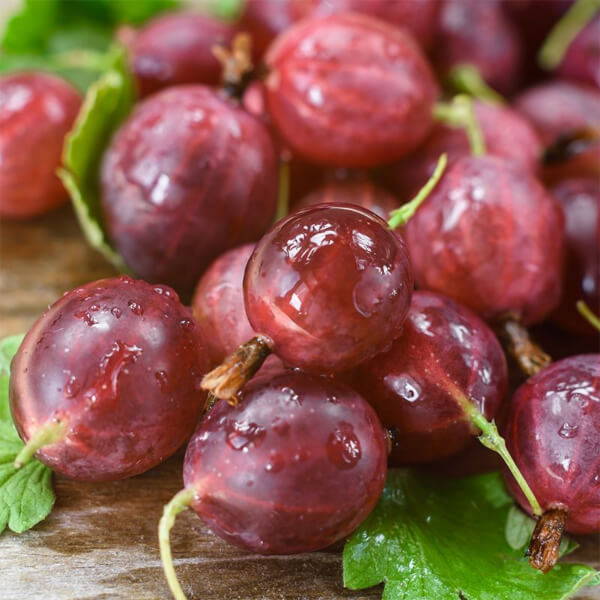
Source: Stark Bros
This gooseberry variety comes from Finland. It has a great flavour and produces generous amounts of fruit. The gooseberries are large and a lovely dark red colour, with skin that is tangy in flavour and sweet inner flesh.
The Hinnomaki Red grows upright and has a strong defence against mildew. This variety is versatile and can be grown either as an ornamental plant or to create a hedge or screen effect in your garden.


Get Your Free Guide:
Master Growing Australian Natives eBook
A Must Have Complete Guide for Every Australian Garden
Get Your Free Guide:
Master Growing Australian Natives eBook
A Must Have Complete Guide for Every Australian Garden
Hinnomaki Red fruit can be enjoyed fresh or otherwise is delicious in baked goods.
Gooseberry Captivator
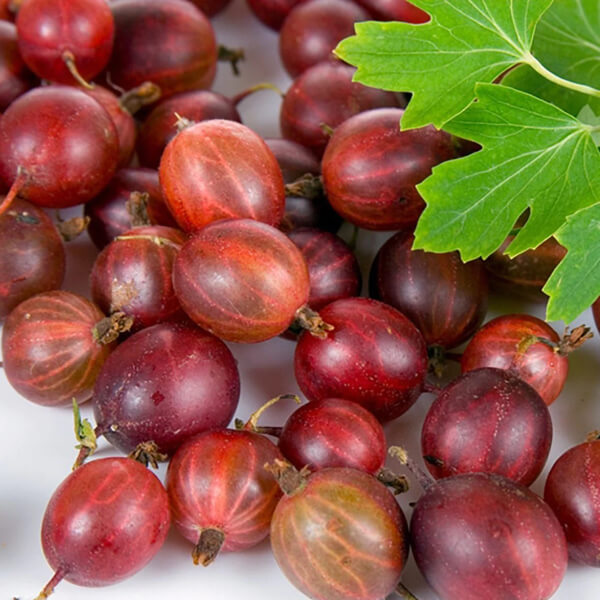
Source: The Diggers Club
This is a mostly thornless variety of gooseberry with fruit that starts off yellow or green and then becomes red when it’s ripe. The fruit is easy to pick and has a plump feel, with a sweet taste. Gooseberry Captivator will make divine jam, just be sure to pick the fruit when it’s pink.
Since this gooseberry variety grows upright, you could also grow it in a pot if you prefer. It will need to grow on a type of support to help the shrub bear fruit. Much like the other varieties, it deals well with resisting mildew and disease.
Sometimes the newer branches of the Gooseberry Captivator have a few thorns but generally they have disappeared by the time you would need to harvest. This gooseberry has a height and spread of 1 metre and produces pink flowers.
Growing Gooseberry Plant in Australia

How to Propagate Gooseberry
You can propagate your own gooseberry shrub using cuttings from a plant that is at least a year old. The best time to take the cuttings is when the leaves have dropped in autumn or just before the buds appear in spring.
Take hardwood cuttings from the gooseberry plant and aim for healthy and strong sections. You can remove the soft tip of the shoot and then section off into pieces that are around 15 cm in length.
At the top of the cutting, slice it at an angle and do it just above a bud. At the bottom of the cutting, make a straight cut across the shoot and do this just below a bud.
Fill up the pots you have prepared for planting with some compost and grit. Before planting the cuttings, dip the bottom into some rooting powder and then plant it to around half its length.
You can press down the potting mixture around your cuttings and then give them water. The cuttings will need to be kept somewhere cold until the next autumn. You can water them now and then just to make sure the potting mix stays moist.
By autumn your cuttings will have new roots and they can then be transplanted to a spot in your garden. It takes about 4 years for the gooseberry plant to be at full fruit producing capacity.
How to Care for Gooseberry
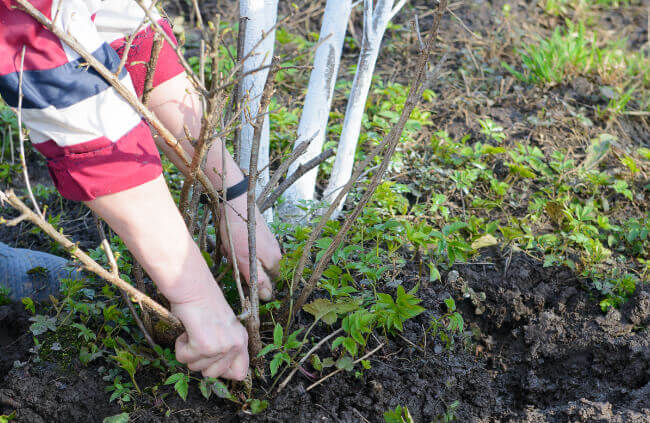
Light
Gooseberries are happy to grow in full sun but also in part shade. When the weather is particularly warm, the plant will need to be protected from midday and afternoon sun which is very hot.
Best Soil for Gooseberries
The great news about gooseberries is that they are able to grow in a variety of soils. However, the best choice is a well-draining and sandy loam soil with plenty of organic matter.
You can add a layer of mulch around the base of your gooseberry shrub which will keep the soil nice and cool but also moist.
Watering Needs
When your gooseberry plant has established itself, you only need to water if there is no regular rainfall. When watering your plant, make sure it's deep watering.
Temperature and Humidity
Gooseberries prefer a cooler climate and don’t like intense heat. If the weather is humid, your gooseberry plant might be at risk for disease. Make sure to space plants well to allow for sufficient air circulation, and prune them each year.
What Fertiliser to Use
You can fertilise your gooseberry shrub at the start of spring. Use a balanced fertiliser to surround each plant and then work into the soil lightly. Gooseberries need plenty of nitrogen so it helps to also add compost manure along with fertiliser.
Pruning Gooseberry
Gooseberry plants will produce fruit on canes or stems that are between 1 and 3 years old. You can do your pruning in winter when the plant is dormant. Remove all old canes which are usually a darker colour, but also any that look damaged or affected by disease.
By pruning your gooseberry shrub each year, you encourage plant growth but also create good air circulation for the plant.
Gooseberries Culinary Use
Gooseberries are usually divided into the culinary types and the dessert types, depending on the level of sweetness. The culinary gooseberries are cooked with sugar to help neutralise the sour flavour. They work well to make jam and pies, and complement pork and fish perfectly.
The dessert gooseberries can be eaten picked straight off the plant as they are sweet and juicy. Gooseberries can be anything from green to red or yellow in colour, depending on the variety.
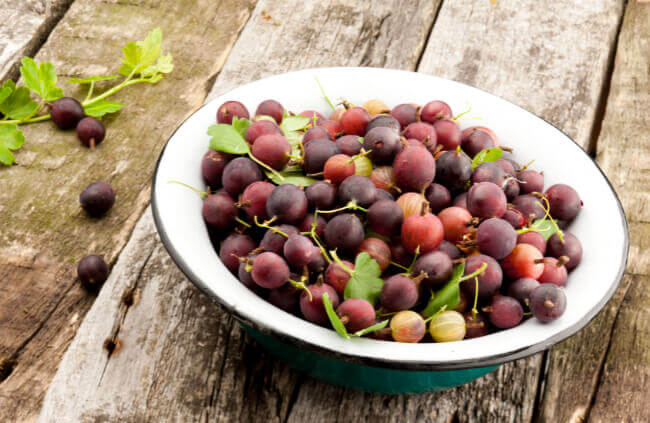
Harvesting Gooseberries
You can harvest your gooseberries anytime from the end of spring to the end of summer. Harvest time will also depend on the variety you are growing. If sweetness is what you’re after, it’s best to wait for the gooseberries to be soft and totally ripe before you pick them.
If your preference is a more tart fruit, you can pick them when they are just a little bit under ripe. Gooseberries are best enjoyed as soon as possible after picking.
If you want to store them for later, you can keep them in the fridge for a week. You can also freeze your gooseberries for a few months.
Common Gooseberry Pests and Diseases
Red spider mite
Spider mites create a type of web on your plant leaves as they feed on them but the leaves also become yellow and spotted, and eventually wilt and fall off. You can get rid of any leaves that are affected and then spray the plant well with a mixture of alcohol and soap.
This treatment should be done a few times per week. You can also use neem oil which is considered a natural pesticide. It actually suffocates the mites, helping to control an infestation.
To make up a solution, you can add a tablespoon of neem oil to about a litre of water and then spray the affected leaves.
Aphids
Signs of aphids are leaves that are yellow or brown, and that start to wilt or curl. You might also notice stunted growth in your gooseberry shrub. Check your plant often for these pests and if you do find them, you can squash them or knock them off the plant with a strong spray of water. A soapy water spray can also be applied to the plant.
Powdery Mildew
Powdery mildew is generally quite easy to spot on your plants as you’ll notice a type of white powder on the leaves. The fungal spores of this disease are spread around by the wind and rain.
Usually powdery mildew will only affect the leaves of your plant. If the infection is really bad, it can affect the development of flowers. This disease thrives in warm weather that is either humid or dry.
You can help limit infection risk by not watering your shrub from above and also make sure it’s well-spaced to allow for good ventilation. If you do encounter powdery mildew on your gooseberry shrub, you can cut off any infected leaves, and then treat by spraying your plant with a baking soda solution, or a neem oil spray. Potassium bicarbonate is also effective.
Gooseberry Sawfly
The larvae of the gooseberry sawfly eat the leaves of the gooseberry greedily, sometimes removing all the leaves. They are about 2 cm in size and are green and black with some spots. The adult sawflies are yellow and black and the females are usually bigger than the males.
You can manage this pest by pruning your plant to allow for good air circulation and it’s good to check your gooseberry shrub often for any damaged leaves. You can remove the larvae by hand or in the case of a big infestation, you can use an organic pesticide like neem oil.
Gooseberry Plant Frequently Asked Questions
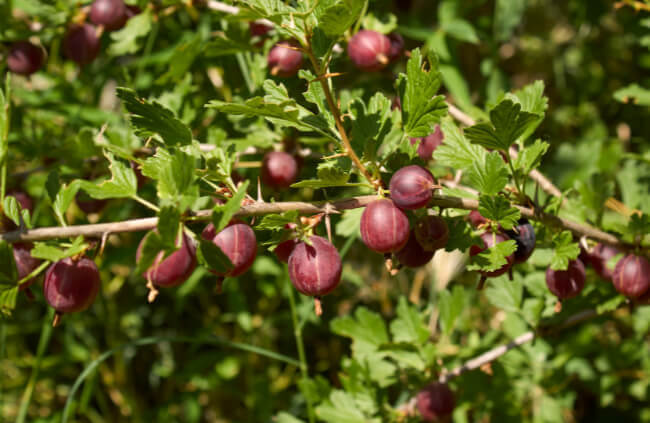
Can you plant gooseberries in a pot?
Yes you can. You’ll need a big pot that has good drainage. As a size guideline, aim for a pot no less than 50 cm wide and 50 cm deep. Fill up the pot with a good quality potting mix, plant the gooseberry, and then pat down the potting mix around the plant.
Give it a good watering to help the roots settle. We also recommend that you mulch the surface of the potting mix. This helps to keep moisture in.
Is there an alternative gooseberry I can plant if I stay in an area that doesn’t have cold enough winters?
The Cape Gooseberry, also known as Physalis peruviana, is a great option. This particular gooseberry has its origins in Peru and Chile. It then arrived in South Africa and was enjoyed by settlers at the start of the 1800s at what was called the Cape of Good Hope.
This is how it earned the name Cape Gooseberry. The delightful fruit then travelled to Australia by ship and soon became popular as it grew and provided fruit quickly in most parts of the country.
Are gooseberries nutritious to eat?
Gooseberry fruit provides generous amounts of vitamin C, fibre, and vitamin A.
Why were gooseberries once illegal in the USA?
The gooseberry shrub was responsible for the spread of a disease called white pine blister rust. It was wiping out large populations of the white pine trees and therefore affected parts of the USA that had lumber as a vital part of their economy.
Where does the name gooseberry come from?
It originates from the word ‘groses’ or ‘grosier’. These are Middle English or old words for ‘grosielle’, which is the French name for redcurrant.
What is the difference between gooseberries and currants?
They are both part of the plant family Grossulariaceae, which includes true gooseberries with spines, and then currants which do not have spines.
Sign up for our newsletter to discover more about our rich and amazing plant life in Australia.
Wrapping Up Our Gooseberry Plant Growing and Care Guide
Gooseberries are a delightful fruit to have in your own garden, and a bonus is that you only need one plant in order to get fruit as they self-pollinate. We are spoiled for choice in terms of varieties to choose from, and within 1 to 3 years you’ll have fruit!
Published on August 13, 2023 by Maisie Blevins
Last Updated on February 24, 2025




